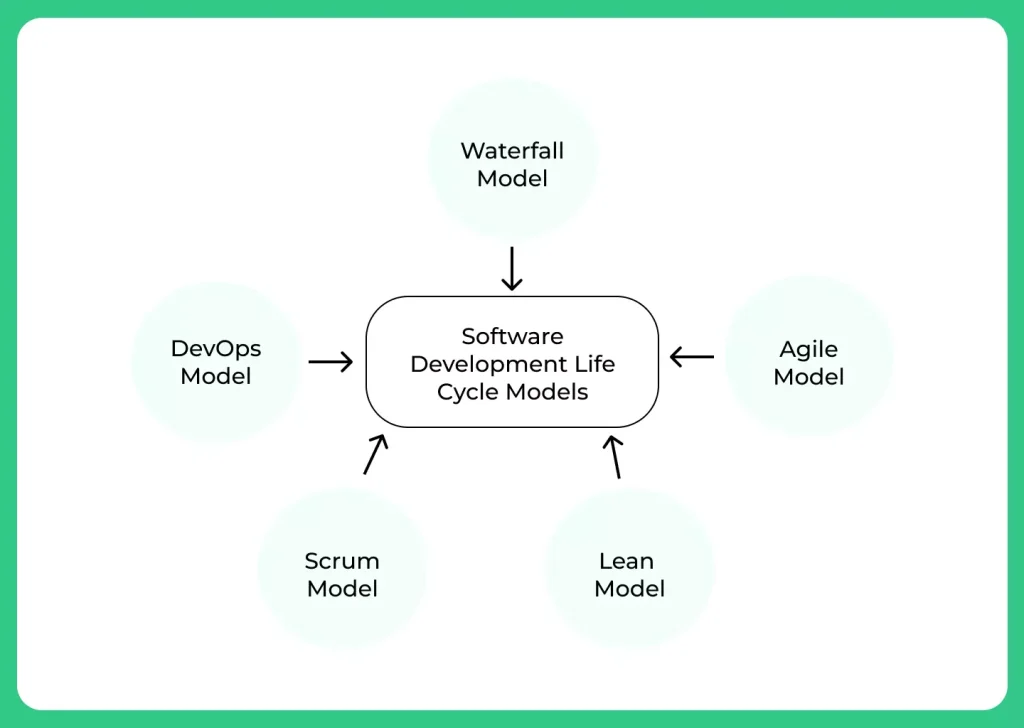Software Development Life Cycle Model (SDLC)
Introduction to Software Development Life Cycle (SDLC)
Software Development Life Cycle Model (SDLC) is a process that outlines the steps involved in creating a software product. It provides a framework for the development and maintenance of software products, and it helps organisations ensure that the software they create meets the needs of users and stakeholders.
There are also different SDLC models, such as the Waterfall Model, Agile Model, V-Model, Spiral Model, and more. Each model follows the basic principles of SDLC but in its own way. The choice of model depends on factors like project size, timeline, client requirements, and available resources.
In this blog, we will explore what SDLC is, why it is important, its various stages, and the different types of SDLC models used in the software industry.

What is Software Development Life Cycle Model (SDLC)?
The Software Development Life Cycle model (SDLC) is a process used by software developers to design, create, test, and deliver software. It’s like a roadmap that guides the development team through each step, ensuring the final product meets the desired requirements.
- The SDLC has several stages, starting with planning, where the project’s goals are defined. Then comes designing the software, followed by writing the actual code in the development phase.
- After that, the software is tested to find and fix any bugs. Once testing is complete, the software is deployed for use. Finally, in the maintenance phase, the software is updated and improved as needed.
- The SDLC helps teams create reliable and efficient software by following a clear and organized approach.
Processes included in Software Development Life Cycle Model (SDLC)
There are many different models for the SDLC, but most of them include the following phases:
Planning:
This phase involves identifying the goals and objectives of the software project, determining the resources and budget required, and creating a project plan.

Analysis:
In this phase, the requirements for the software are gathered and analyzed. This may involve conducting user interviews, creating user stories or user scenarios, and defining the functional and non-functional requirements of the software.

Design:
During the design phase, the software architecture and user interface are created. This may involve creating mockups, wireframes, and prototypes, as well as defining the technical architecture of the software.

Implementation:
In this phase, the code for the software is written. This may involve writing individual modules or features, integrating them into the larger system, and testing them to ensure they work correctly.

Testing:
During the testing phase, the software is thoroughly tested to ensure that it meets the requirements defined in the analysis phase and functions correctly. This may involve creating test cases, running automated tests, and conducting user acceptance testing.

Deployment:
Once the software has been thoroughly tested and is ready for release, it is deployed to production environments where it can be used by end users.

Maintenance:
Even after the software has been deployed, it will need ongoing maintenance to fix bugs, add new features, and make other improvements. This phase involves monitoring the software for issues, addressing them as needed, and releasing updates and patches to keep the software running smoothly.

Various models used in Software Development Life Cycle

There are several different SDLC models that have been developed over the years, each with its own unique approach to the software development process. Some of the most common SDLC models include:
Waterfall model:
This is a traditional and linear approach to software development, in which each phase of the process is completed before moving on to the next.
🚀 More about Waterfall Model
Agile model:
This is a flexible and iterative approach to software development, in which the process is divided into small, incremental phases called “sprints.”
🚀 More about Agile Model
Scrum model:
This is a popular variation of the agile model, in which a team works collaboratively to deliver small, incremental improvements to the software in short, intense bursts of activity called “sprints.”
Lean model:
This is an approach to software development that emphasises the importance of continuously improving the efficiency of the process and eliminating waste.
DevOps model:
This is an approach to software development that combines the principles of agile and lean methodologies with a focus on automation and collaboration between development and operations teams.
More models of SDLC –
Spiral Model in SDLC
The Spiral Model combines the features of both the Waterfall and Iterative models. It focuses on risk analysis and involves repeated cycles (or spirals) of planning, developing, testing, and evaluating. This model is ideal for large and complex projects with frequent changes.
🚀 More about Spiral Model
RAD (Rapid Application Development) Model in SDLC
The RAD Model emphasizes quick development using rapid prototyping and user feedback. It allows teams to build functional components in parallel and integrate them quickly. This model works best for projects that require fast delivery and have well-defined requirements.
🚀 More about Spiral Model
V Model in SDLC
The V Model (Verification and Validation Model) is an extension of the Waterfall Model where each development phase is associated with a corresponding testing phase. It forms a V-shape that represents the development on the left side and testing on the right side. This model ensures early detection of defects and improves software quality.
🚀 More about Spiral Model
SDLC Interview Questions
We provided you best top 10 interview questions with answers asked in the best company –
1. What is SDLC? Why is it important?
Answer: SDLC stands for Software Development Life Cycle. It is a structured process used for developing high-quality software in a systematic and cost-effective way. It includes stages like planning, analysis, design, development, testing, deployment, and maintenance. It ensures better project management, timely delivery, and quality output.
2. What are the different phases of SDLC?
Answer: The major phases of SDLC are:
- Requirement Gathering and Analysis
- System Design
- Implementation (Coding)
- Testing
- Deployment
- Maintenance
3. Which SDLC model is the best and why?
Answer: There is no “one-size-fits-all” model. The choice depends on the project type:
- Waterfall: Best for small, well-defined projects
- Agile: Best for dynamic projects with changing requirements
- Spiral: Best for high-risk and large projects
- V Model: Best for projects with strict validation needs
- RAD: Best for projects requiring quick delivery
4. What is the difference between Agile and Waterfall model?
Answer:
- Waterfall is a linear and sequential approach; once a phase is completed, you can’t go back.
- Agile is iterative and allows frequent changes. Development and testing are done simultaneously with continuous feedback.
5. Explain the V-Model in SDLC.
Answer: The V-Model is an extension of the Waterfall Model. Each development phase has a corresponding testing phase. It emphasizes early testing and ensures validation at every level, improving product quality and reducing bugs.
Is SDLC 6 or 7?
The Software Development Life Cycle (SDLC) is a structured approach used for developing software efficiently and with high quality. The number of phases in SDLC can vary slightly depending on the methodology or the organization implementing it. Typically, SDLC is considered to have 6 or 7 phases. Here’s a breakdown to clarify:
6 Phases of SDLC (Traditional View):
- Requirement Gathering and Analysis
- Understand client needs and expectations.
- Stakeholders, users, and developers collaborate.
- The outcome is a clear and detailed set of requirements.
- System Design
- Architecture of the system is planned.
- Includes database design, interface design, and data flow diagrams.
- Implementation (or Coding)
- Developers write the actual code based on design documents.
- Programming languages and tools are used to build the software.
- Testing
- Quality assurance team checks for bugs, performance issues, and security loopholes.
- Unit testing, integration testing, system testing, and user acceptance testing are conducted.
- Deployment
- The software is released to users.
- May be done in stages (pilot launch, full rollout).
- Maintenance
- Continuous updates, bug fixes, and improvements post-deployment.
- Software evolves based on user feedback and new requirements.
7 Phases of SDLC (Extended View):
Some models break down the first phase into two distinct phases, making it 7 stages in total:
- Planning
- High-level project planning, cost estimation, and feasibility analysis.
- Helps define the scope and allocate resources.
- Requirement Analysis
- Deep dive into the requirements, identifying user expectations in detail.
- Often involves creating use cases and requirement documents.
- Design
- Same as in the 6-phase model.
- Implementation
- Testing
- Deployment
- Maintenance
So, is SDLC 6 or 7?
- Both are correct, depending on how you define and group the stages.
- 6-phase SDLC often merges planning and requirements.
- 7-phase SDLC separates them for clarity and detailed analysis.
FAQs
The SDLC typically includes phases like requirement gathering, design, development, testing, deployment, and maintenance. Each phase ensures a smooth transition to the next and contributes to the final product.
It helps ensure a systematic approach, reducing risks and project failures. It also improves project planning, control, and predictability.
Popular SDLC models include Waterfall, Agile, Spiral, and V-Model. Each has its own approach to handling software development stages




Login/Signup to comment